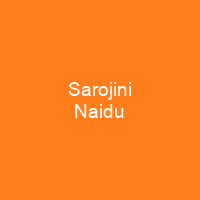Sarojini Chattopadhyay Naidu was an Indian political activist and poet. She was an important figure in India’s struggle for independence from colonial rule. Her work as a poet earned her the sobriquet ‘Nightingale of India’ by Mahatma Gandhi. She later became the Governor of the United Provinces in 1947.
About Sarojini Naidu in brief

At that time, Inter-caste marriages were not as common as they are today, but both their families approved their marriage. She had five children with him. Her brother Virendranath was a revolutionary, and another brother Harindranth was a poet, a dramatist, and an actor. Her father, Aghorenath Chattopdhyay, with a doctorate of Science from Edinburgh University, settled in Hyderabad, where he administered Hyderabad college, which later became Nizam College. She became a part of Indian nationalist movement and became a follower of Mahatman Gandhi and his idea of swaraj. She joined the Indian independence movement in the wake of partition of Bengal in 1905. She soon met other such leaders as Gopal Krishna Gokhale, Rabindra Tagore, Mahatmah Gandhi and others. She also helped to establish the Women’s Indian Association in 1917.
You want to know more about Sarojini Naidu?
This page is based on the article Sarojini Naidu published in Wikipedia (as of Nov. 30, 2020) and was automatically summarized using artificial intelligence.







